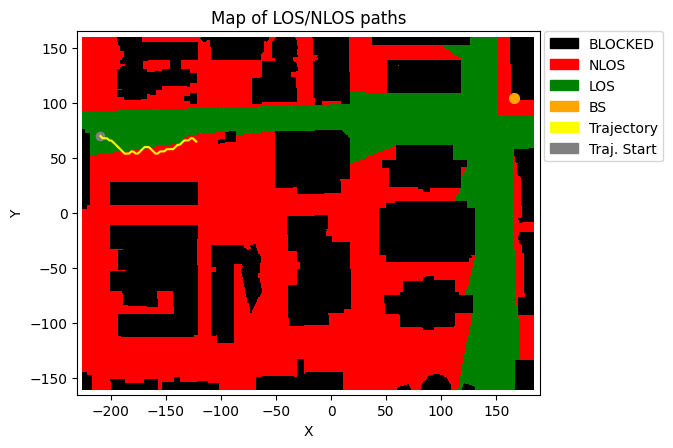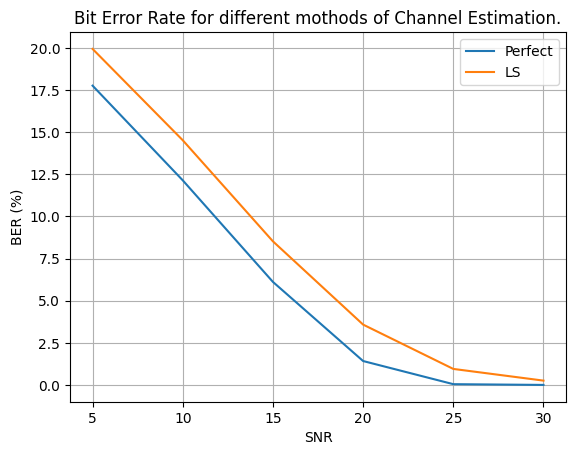An end-to-end PDSCH Simulation with Trajectory-based Channel Model
This notebook shows how to create an end-to-end PDSCH communication and calculate the bit error rate while the user is moving on a trajectory.
[1]:
import numpy as np
import scipy.io
import time
import matplotlib.pyplot as plt
from neoradium import DeepMimoData, TrjChannel, Carrier, PDSCH, AntennaPanel, Grid, random
[2]:
# Replace this with the folder on your computer where you store DeepMIMO scenarios
dataFolder = "/data/RayTracing/DeepMIMO/Scenarios/V4/"
DeepMimoData.setScenariosPath(dataFolder)
# Create a DeepMimoData object
deepMimoData = DeepMimoData("asu_campus_3p5")
deepMimoData.print()
DeepMimoData Properties:
Scenario: asu_campus_3p5
Version: 4.0.0a3
UE Grid: rx_grid
Grid Size: 411 x 321
Base Station: BS (at [166. 104. 22.])
Total Grid Points: 131,931
UE Spacing: [1. 1.]
UE bounds (xyMin, xyMax) [-225.55 -160.17], [184.45 159.83]
UE Height: 1.50
Carrier Frequency: 3.5 GHz
Num. paths (Min, Avg, Max): 0, 6.21, 10
Num. total blockage: 46774
LOS percentage: 19.71%
[3]:
random.setSeed(123) # Make results reproducible
# Create the carrier:
carrier = Carrier(startRb=0, numRbs=25, spacing=30) # Carrier with 25 Resource Blocks, 15KHz subcarrier spacing
bwp = carrier.curBwp # The only bandwidth part in the carrier
# Create a random trajectory at waking speed.
trajectory = deepMimoData.getRandomTrajectory(xyBounds=np.array([[-210, 40], [-120, 100]]), # Traj. bounds
segLen=2, # Num grid points on shortest segment
bwp=bwp, # The bandwidth part
trajLen=100, # Number of grid points on trajectory
speedMps=14, # Speed in mps
trajDir="+X") # Trajectory direction
trajectory.print() # Print the trajectory information
deepMimoData.drawMap("LOS-NLOS", trajectory) # Draw the Map with the trajectory
Trajectory Properties:
start (x,y,z): (-209.55, 69.83, 1.50)
No. of points: 15333
curIdx: 0 (0.00%)
curSpeed: [ 9.9 -9.9 0. ]
Total distance: 107.30 meters
Total time: 7.666 seconds
Average Speed: 13.996 m/s
Carrier Frequency: 3.5 GHz
Paths (Min, Avg, Max): 6, 8.99, 10
Totally blocked: 0
LOS percentage: 29.09%
[3]:
(<Figure size 742.518x471.734 with 1 Axes>,
<Axes: title={'center': 'Map of LOS/NLOS paths'}, xlabel='X', ylabel='Y'>)

[4]:
numFrames = 100 # Number of time-domain frames (The first second on the trajectory)
snrDbs = [5,10,15,20,25,30] # SNR values (in dB) for which we want to evaluate the model
freqDomain = False # Set to True to apply channel in frequency domain
modulation = "16QAM" # Modulation Scheme
# Create a PDSCH object
pdsch = PDSCH(bwp, interleavingBundleSize=0, numLayers=2, nID=carrier.cellId, modulation=modulation)
pdsch.setDMRS(prgSize=0, configType=2, additionalPos=2) # Specify the DMRS configuration
numSlots = bwp.slotsPerFrame*numFrames # Total number of slots
results = {} # Dictionary to save the results
# Creating a trajectory-based channel model:
channel = TrjChannel(bwp, trajectory,
txAntenna = AntennaPanel([2,4]), # 8 TX antenna
txOrientation = [180,0,0], # Make the BS antenna face to the left.
rxAntenna = AntennaPanel([1,2]), # 2 RX antenna
seed = 123)
minMse, maxMse = 100, 0
for chanEstMethod in ["Perfect", "LS"]: # Two different channel estimation methods
results[chanEstMethod] = {}
print(f"\nSimulating end-to-end with \"{modulation}\", and \"{chanEstMethod}\" channel estimation, " +
f"in {'frequency' if freqDomain else 'time'} domain.")
print("SNR(dB) Total Bits Bit Errors BER(%) Point time(Sec.)")
print("------- ---------- ---------- ------ ----- ----------")
for snrDb in snrDbs:
random.setSeed(123) # Making the results reproducible.
t0 = time.time()
channel.restart()
bitErrors = 0
totalBits = 0
for slotNo in range(numSlots):
grid = pdsch.getGrid() # Create a resource grid already populated with DMRS
numBits = pdsch.getBitSizes(grid)[0] # Actual number of bits available in the resource grid
txBits = random.bits(numBits) # Create random binary data
# Now populate the resource grid with coded data. This includes QAM modulation and resource mapping.
pdsch.populateGrid(grid, txBits)
# Store the indexes of the PDSCH data in pdschIndexes to be used later.
pdschIndexes = pdsch.getReIndexes(grid, "PDSCH")
# Getting the Precoding Matrix, and precoding the resource grid
channelMatrix = channel.getChannelMatrix() # Get the channel matrix
precoder = pdsch.getPrecodingMatrix(channelMatrix) # Get the precoder matrix from PDSCH object
precodedGrid = grid.precode(precoder) # Perform the precoding
if freqDomain:
rxGrid = precodedGrid.applyChannel(channelMatrix) # Apply the channel in frequency domain
rxGrid = rxGrid.addNoise(snrDb=snrDb) # Add noise
else:
txWaveform = precodedGrid.ofdmModulate() # OFDM Modulation
maxDelay = channel.getMaxDelay() # Get the max. channel delay
txWaveform = txWaveform.pad(maxDelay) # Pad with zeros
rxWaveform = channel.applyToSignal(txWaveform) # Apply channel in time domain
noisyRxWaveform = rxWaveform.addNoise(snrDb=snrDb, nFFT=bwp.nFFT) # Add noise
offset = channel.getTimingOffset() # Get timing info for synchronization
syncedWaveform = noisyRxWaveform.sync(offset) # Synchronization
rxGrid = syncedWaveform.ofdmDemodulate(bwp) # OFDM demodulation
if chanEstMethod == "Perfect": # Perfect Channel Estimation
estChannelMatrix = channelMatrix @ precoder[None,...]
else: # LS + Interpolation Channel Estimation
estChannelMatrix, noiseEst = rxGrid.estimateChannelLS(pdsch.dmrs, polarInt=False,
kernel='linear')
act = channelMatrix @ precoder[None,...]
mse1 = np.square(np.abs(estChannelMatrix - act)).mean()
fEst = np.stack([estChannelMatrix.real, estChannelMatrix.imag], axis=4)
fAct = np.stack([act.real, act.imag], axis=4)
mse2 = np.square(fEst - fAct).mean()
if minMse>mse2: minMse=mse2
if maxMse<mse2: maxMse=mse2
eqGrid, llrScales = rxGrid.equalize(estChannelMatrix) # Equalization
rxBits = pdsch.getHardBitsFromGrid(eqGrid, pdschIndexes)[0] # Demodulation
bitErrors += np.abs(rxBits-txBits).sum() # Calculating number of bit errors
totalBits += numBits
print("\r %3d %8d %8d %6.2f %6d %6.2f"%(snrDb, totalBits, bitErrors,
bitErrors*100/totalBits, slotNo+1,
time.time()-t0), end='')
channel.goNext() # Prepare the channel model for the next slot
dt = time.time()-t0 # Total time for this SNR
results[chanEstMethod][snrDb] = {"totalBits":totalBits,
"bitErrors":bitErrors,
"BER": bitErrors*100/totalBits,
"Time": dt}
print("\r %3d %8d %8d %6.2f %6d %6.2f"%(snrDb, totalBits, bitErrors,
bitErrors*100/totalBits, slotNo+1, dt))
# Compare the results in a plot:
for i,chanEstMethod in enumerate(['Perfect', 'LS']):
bers = [results[chanEstMethod][snrDb]["BER"] for snrDb in snrDbs]
plt.plot(snrDbs, bers, label=chanEstMethod)
plt.legend()
plt.title("Bit Error Rate for different methods of Channel Estimation.");
plt.grid()
plt.xlabel("SNR")
plt.xticks(snrDbs)
plt.ylabel("BER (%)")
# plt.yscale('log')
plt.show()
Simulating end-to-end with "16QAM", and "Perfect" channel estimation, in time domain.
SNR(dB) Total Bits Bit Errors BER(%) Point time(Sec.)
------- ---------- ---------- ------ ----- ----------
5 62400000 11082525 17.76 2000 170.12
10 62400000 7576802 12.14 2000 171.35
15 62400000 3814882 6.11 2000 169.40
20 62400000 884722 1.42 2000 168.70
25 62400000 27923 0.04 2000 168.67
30 62400000 18 0.00 2000 167.88
Simulating end-to-end with "16QAM", and "LS" channel estimation, in time domain.
SNR(dB) Total Bits Bit Errors BER(%) Point time(Sec.)
------- ---------- ---------- ------ ----- ----------
5 62400000 12443206 19.94 2000 172.28
10 62400000 9061276 14.52 2000 172.68
15 62400000 5317476 8.52 2000 171.76
20 62400000 2233990 3.58 2000 171.66
25 62400000 592511 0.95 2000 171.69
30 62400000 159383 0.26 2000 171.65

[ ]:
[ ]: